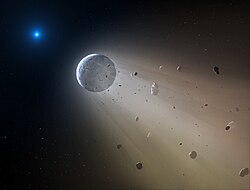
In astronomy, a disrupted planet[1][2] is a planet or exoplanet or, perhaps on a somewhat smaller scale, a planetary-mass object, planetesimal, moon, exomoon or asteroid that has been disrupted or destroyed by a nearby or passing astronomical body or object such as a star.[1][2] Necroplanetology is the related study of such a process.[3][4]
The result of such a disruption may be the production of excessive amounts of related gas, dust and debris,[5] which may eventually surround the parent star in the form of a circumstellar disk or debris disk. As a consequence, the orbiting debris field may be an "uneven ring of dust", causing erratic light fluctuations in the apparent luminosity of the parent star, as may have been responsible for the oddly flickering light curves associated with the starlight observed from certain variable stars, such as that from Tabby's Star (KIC 8462852), RZ Piscium and WD 1145+017.[3][4] Excessive amounts of infrared radiation may be detected from such stars,[6] suggestive evidence in itself that dust and debris may be orbiting the stars.[5][7][8][9]
- ^ a b Staff (22 December 2017). "Young Star RZ Piscium is 'Eating' Its Own Planets, Astronomers Say". Sci-News.com. Retrieved 23 December 2017.
- ^ a b Fryling, Kevin (21 December 2017). "IU astronomer's analysis helps discover that a star in the constellation Pisces is a 'planet-eater'". Indiana University. Retrieved 23 December 2017.
- ^ a b Starr, Michelle (28 March 2020). "Necroplanetology: The Strangest Field of Astronomy You've Never Heard Of". ScienceAlert.com. Retrieved 30 March 2020.
- ^ a b Duvvuri, Girish M.; Redfield, Seth; Veras, Dimitri (18 March 2020). "Necroplanetology: Simulating the Tidal Disruption of Differentiated Planetary Material Orbiting WD 1145+017". The Astrophysical Journal. 893 (2): 166. arXiv:2003.08410. Bibcode:2020ApJ...893..166D. doi:10.3847/1538-4357/ab7fa0. S2CID 213004256.
- ^ a b Punzi, K. M.; Kastner, J. H.; Melis, C.; Zuckerman, B.; Pilachowski, C.; Gingerich, L.; Knapp, T. (21 December 2017). "Is the Young Star RZ Piscium Consuming Its Own (Planetary) Offspring?". The Astronomical Journal. 155 (1): 33. arXiv:1712.08962. Bibcode:2018AJ....155...33P. doi:10.3847/1538-3881/aa9524. S2CID 119530135.
- ^ Farihi, J.; Jura, M.; Zuckerman, B. (10 March 2009). "Infrared Signatures of Disrupted Minor Planets at White Dwarfs". The Astrophysical Journal. 694 (2): 805–819. arXiv:0901.0973. Bibcode:2009ApJ...694..805F. doi:10.1088/0004-637X/694/2/805. S2CID 14171378.
- ^ Landau, Elizabeth (4 October 2017). "Mysterious Dimming of Tabby's Star May Be Caused by Dust". NASA. Retrieved 23 December 2017.
- ^ Meng, Huan Y.A.; et al. (3 October 2017). "Extinction and the Dimming of KIC 8462852". The Astrophysical Journal. 847 (2): 131. arXiv:1708.07556. Bibcode:2017ApJ...847..131M. doi:10.3847/1538-4357/aa899c. S2CID 118875846.
- ^ Tabor, Abby (5 October 2017). "The scientific quest to explain Kepler's most enigmatic find". Phys.org. Retrieved 23 December 2017.